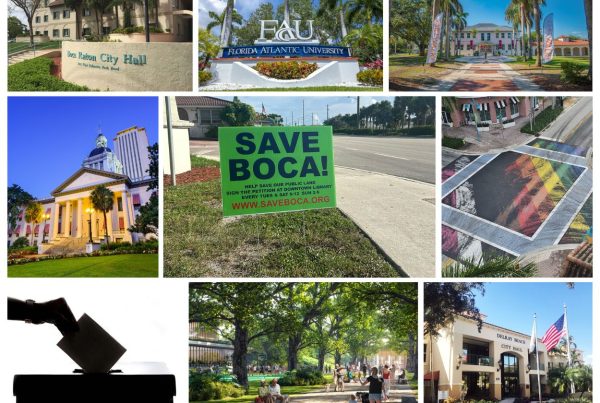Another Broward County?

For a very long time, most elected officials in Palm Beach County have used Broward County to show what they don’t want this county to look like. Put-up-or-shut-up time is coming.
A second meeting this week to discuss the future of the county’s Agricultural Reserve Area ended about the same way the first one did: with no compromise in sight. Small farmers still want the ability to sell their land at the highest residential/commercial development price. Opponents want no more houses in the reserve, citing the 1999 vote by voters to tax themselves $100 million for a land-buying program to keep as much farming in the reserve—between Lantana and Clint Moore roads west of State Road 7—as possible. Of the roughly 20,000 acres in the reserve, about half remains in agriculture.
Though there’s nothing close to a consensus, a proposal that could allow between about 1,000 and 7,000 more homes will go to the county commission for discussion (but not a vote) on March 24. Unless the commission takes a new approach, Palm Beach County could lose a unique, productive coastal farming area and look more like Broward County (above photo). Lisa Interlandi of the Everglades Law Center said in an interview, “The changes that they’ve looked at would destroy the Ag Reserve.”
The push for the changes comes from some small farmers and nursery owners who claim that they can’t make money under current conditions and want to sell. The 1999 preservation plan allowed some development—enough, the critics say, to hinder their operations because of traffic, among other things. Encouraging these farmers is GL Homes, the main developer in and near the reserve.
Details of the proposal are complex. In essence, though, the county would allow development on smaller pieces of property if the owner preserved land elsewhere in the reserve. Currently, developers must set aside land for preservation on the development site.
The idea can sound tempting. Hey, if the same amount of land gets preserved, that works, right? Not really. As more development speckled the reserve, the clash between homes and farms would intensify. In South Florida, homes almost always win those battles. Eventually, the reserve would become fully developed, and that vote in 1999 would mean nothing. “If the county wants to preserve agriculture,” Interlandi said, “the worst thing is to build more rooftops.”
And as Interlandi and other advocates for preservation point out, the only proposal is one that allows more homes and shopping centers. There is no proposal aimed at helping the farmers, some of whom might want to keep farming, as opposed to those who, as Interlandi says, “have dollar signs in their eyes.”
Indeed, given that 1999 vote the county has no obligation to give certain farmers a windfall in a way that could undercut the public’s wish. The referendum passed by roughly a 2-to-1 margin. But the county has options beyond this one from a developer.
For example, the county could help farmers market their land to farmers in the reserve who want to expand or people who want to get started in farming. The county could create a compensation program to encourage landowners to stay in agriculture. The county could promote the reserve and its role in supplying produce for area restaurants and schools. And with the campaign continuing for medical marijuana in Florida, maybe those farmers aren’t considering every crop they might plant.
I am told that county staff members didn’t consider an alternate approach because they believed that the commission asked only for ideas about development. Whether that’s true or not, this issues needs more voices and a fresh perspective. That shift may have to come from the commissioners during that discussion next month.
By approving mini-city Minto West last summer, the commission made it likelier that west-central Palm Beach County will look more like Broward. If the commission allows more development in the Agricultural Reserve, you won’t have to drive to Broward. It will be here.
Guns R Us
Three months ago, a shooting at Florida State University in Tallahassee left three students wounded. Predictably, the response from another Tallahassee institution—the Florida Legislature—is a bill that would allow students with concealed-carry permits to have guns on state university campuses. Sen. Greg Evers, R-Pensacola, claims that Senate Bill 176 would allow students to defend themselves. This week, he noted the many sex offenders who live near FSU and claimed that keeping the campus gun-free endangers students. The Criminal Justice Committee approved Evers’ bill 3-2. The House companion bill is HB 4005.
At Florida Atlantic University and the other 11 public universities, however, administrators and campus police don’t agree with Evers. When I asked an FAU spokesman this week for President John Kelly’s opinion on the legislation, the spokesman directed me to a statement from the Board of Governors, which oversees the State University System, and said Kelly supports it:
“Florida has long recognized the importance of protecting its students and the environment in which they learn by prohibiting firearms in university facilities.” The board and the individual universities “are united in the belief that removing that long-standing protection is contrary to the values we embrace and could create new challenges in our ability to provide a safe and secure learning environment.”
In a letter to Evers, the 12 campus police chiefs made the most cogent point. Citing that FSU shooting, the chiefs wrote:
“With officers arriving within minutes to a chaotic scene and with victims wounded, the only description provided to law enforcement about the shooter from frantic eyewitnesses was that the suspect was black and wore a ‘Skully’ type hat. The officers … applied their hundreds of hours of training to identify the suspect, give him clear commands to drop his weapon, and ultimately they stopped the suspect. Citizens are not trained for this type of response.”
That is especially true of citizens whose decision-making parts of their brains aren’t fully developed. The last time the Legislature debated such a bill, John Thrasher blocked its approval. A state senator at the time, Thrasher is the new president of FSU, having gotten the job because the FSU trustees liked his political influence. FSU and all the universities will need that influence to keep campuses from becoming more dangerous.
New trustees
Speaking of FAU, Gov. Rick Scott last week reappointed Jeffrey Feingold and Robert Rubin to the university’s board of trustees. They get new five-year terms.
The terms of Anthony Barbar and David Feder also are expiring. Barbar and Feder were appointed by the Board of Governors, which should decide at its March meeting whether the two trustees will stay. Since Barbar was just reelected board chairman—with Dan Cane, founder of Boca Raton-based Modernizing Medicine as vice-chairman—the BOG likely will let him stay.
Investing in yourself
On Tuesday, I wrote that Boca Raton City Council Frank Chapman is financing his Seat 3 campaign with $102,000 of his own money. Chapman isn’t the only candidate making a six-figure donation to himself.
In Delray Beach, Mayor Cary Glickstein has loaned his campaign $100,000. Glickstein faces former Mayor Tom Carney in a rematch from 2013. Carney has loaned himself $1,000. Both figures are through Feb. 6.
The Boyleston issue
Delray Beach should learn Friday if the city has a third contest in the March 10 election.
Ryan Boylston had filed to challenge Seat 1 incumbent Shelly Petrolia, but he was disqualified for not having the necessary 250 valid petition signatures from registered voters. Boylston has filed a lawsuit, claiming that the city clerk’s office and the supervisor of elections office did not notify him in time for him to submit more. A hearing is set for Friday at 9:30 a.m. before Palm Beach County Circuit Judge Meanu Sasser.
••••••••
You can email Randy Schultz at randy@bocamag.com
For more City Watch blogs, click here.About the Author
Randy Schultz was born in Hartford, Conn., and graduated from the University of Tennessee in 1974. He has lived in South Florida since then, and in Boca Raton since 1985. Schultz spent nearly 40 years in daily journalism at the Miami Herald and Palm Beach Post, most recently as editorial page editor at the Post. His wife, Shelley, is director of The Learning Network at Pine Crest School. His son, an attorney, and daughter-in-law and three grandchildren also live in Boca Raton. His daughter is a veterinarian who lives in Baltimore.







